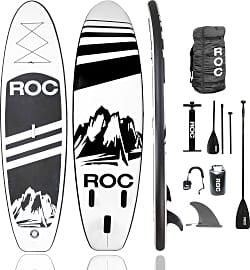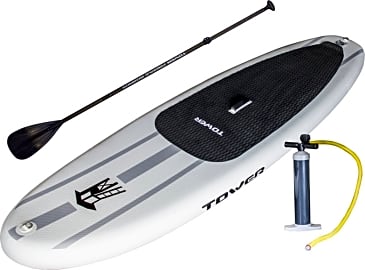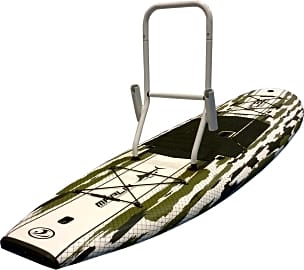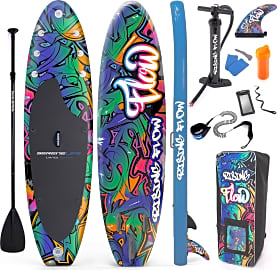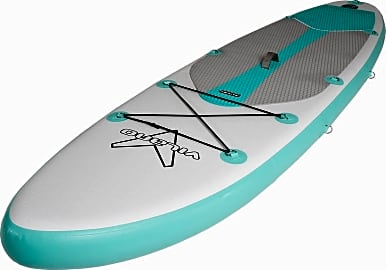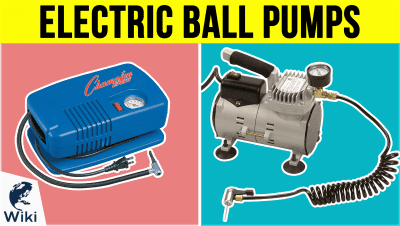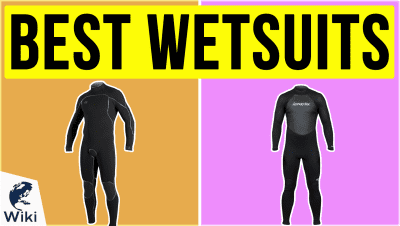The 10 Best Paddleboards

This wiki has been updated 43 times since it was first published in May of 2015. Everyone enjoys fun on the water, so treat yourself or your family to a new hobby with one of these paddleboards that will have you all scooting around on your nearest lake or ocean in no time. We've included solid and inflatable options to provide an enjoyable form of exercise that strengthens the core, back, arms, and legs, as well as relaxing activities, like fishing or yoga. When users buy our independently chosen editorial choices, we may earn commissions to help fund the Wiki.
Editor's Notes
June 08, 2020:
Since we last visited this category, we've found it necessary to dump the likes of the Bic Sport Ace-Tec Cross for durability issues, as it had a tendency to crack if you pushed it even a hair past the recommended psi. A lot of riders go a little over the recommended number to ensure a solid feel, and while we don't condone ignoring manufacturer recommendations, we understand that that it can be tough to nail peak psi with the simple hand pumps most boards include. It might be a better choice if you had an electric pump, but we wouldn't want to list an item that'd require such an additional purchase for safe use.
As paddleboarding continues to grow in popularity, a lot of people looking for boards are shopping for their first one, and we wanted to keep a good balance here of quality, accessibility and performance here for newcomers without sacrificing options for seasoneed riders. That's why you see something like the Red Paddle Co Dragon so highly rated. It's geared toward a more experienced rider, and its construction it outstanding as a result. That said, something like the Retrospec Weekender, which is similarly pointed away from first timers doesn't boast the pro-level build of the Dragon. Beginners should, of course, stick to wider boards, which are easier to balance and control.
Special Honors
Surftech Generator Tuflite VT This model is available in a pair of lengths, with its longest option measuring in at 11-1/2 feet. It's rated to provide a little more stability than speed, and it can handle moderate chop so long as the water conditions don't exceed your skill level. Its construction combines a host of materials, from fused-cell EPS in the core to carbon patches on the tail, making it both exceedingly durable and a tad expensive. surftech.com
Jarvis Boards San Marcos There are two ways you can go about getting a board from this company. First, you can see what they've made in the past and submit an idea for a custom build based on their foundational models. Second, you can pick up one of their DIY kits and actually build your own board at home. That second selection will require a lot of time, patience, and space, however. jarvisboards.com
Finding Your Perfect Paddleboard
If you're looking for a paddleboard you will use primarily for casual cruising across placid water, then a long, large board is the right choice.
To the untrained eye, it might seem that most paddleboards are more or less similar. While they are all designed to be used by a standing rider controlling him or herself using a paddle, that's where many similarities stop. Before you choose the right one for yourself, first you need to think not about the board, but about your prospective activities.
If you're looking for a paddleboard you will use primarily for casual cruising across placid water, then a long, large board is the right choice. Size adds stability, and if your intention is to use your board to cover long distances or to get exercise, you'll appreciate having a stable platform on which to do so.
If you're more of an adventure seeker, and you want to ride your board in rough seas, catching waves and going with the current, then a shorter board with a more angular shape is likely a better choice. It's no coincidence that many paddleboards designed for more active use look very much like the surfboards that inspired them.
There is a surprisingly large number of factors to be considered even once you have defined the type of activity for which you will use your board. If you want a board on which to cruise over open water, what accessories interest you? Some paddleboards have cargo nets that can be used to secure a bit of gear, a waterproof speaker, or a water bottle, making long rides more pleasurable. Others can be fitted with as many as three fins, which allow for excellent tracking control as you cut a path through the water.
And then, of course, you must make one of the largest decisions a prospective paddleboard owner ever asks himself or herself: it is the choice of a rigid board or an inflatable paddleboard. Inflatable paddle boards can be impressively stable and durable, offering an agile platform on which to carve through moderate surf or a stable surface that can glide across water. Inflatables are also much easier to transport and store, of course, requiring only a spot in the trunk or under the bed when not in use. Inflatables are often more affordable than solid-bodied boards, as well, making them the smarter move for the newcomer to the activity who is not yet sure they will be a diehard enthusiast.
Ultimately, a hardbodied paddleboard is more durable than an inflatable option, though, and these boards do offer better control in waves, choppy seas, or the faster current of a moving river. If you have the space to store a paddleboard and the wherewithal to move it inside or atop a vehicle, then a hardbodied board is the better choice for the dedicated paddleboard user who will use his or her board often.
The Basics Of Paddleboard Safety
If you want to be safe on a paddleboard, it's first and foremost critical that you can be safe in the water. That means you should have at least basic swimming proficiency, and that you should wear a lifejacket if you are not a competent, strong swimmer. And in many areas, the USCG (United States Coast Guard) has established regulations that establish these boards as vessels and made lifejacket use mandatory for paddleboard users under the age of 13. Never take your board to a distance farther from shore (or from a boat) than you could easily cover by swimming alone should the need arise.
Beyond a lifejacket, it's not a bad idea to wear a helmet for those initial few practice sessions. Bad injuries have happened more than once when a boarder struck his or her head on their own board during a fall. A wetsuit can offer protection from scratches or scrapes, and of course can keep you warm in cool water. Sunblock is always a good idea for exposed skin, to prevent burns and reduce the chances of skin cancers later in life.
Don't attempt a given activity on a paddleboard, such as catching waves or running river rapids, until you have mastered the basics of keeping upright and balanced on flat water. Remember, practice not only makes perfect, but it leads to safety, too.
The Brief History Of The Paddleboard
People may well have been paddleboarding for hundreds or even thousands of years; we'll likely never be certain of the exact dates of the activity. What can be known for certain is that by the 18th century, it was an established enough practice to make its way into the artwork of Europeans visiting Polynesian islands.
Their popularity as a separate sport cemented at the end of the 20th century, as people finally embraced paddleboarding as its own distinct activity.
Surfing has always been popular with Polynesian natives, and the practice quickly enthralled many Westerners, as well. Already a burgeoning surf culture existed in Hawaii and on the American west coast by the end of the 19th century. Modern paddleboarding took longer to catch on as a noted hobby, however. There were limited examples of paddleboarding seen throughout the 1900s up until the last two decades of the century.
In the late 1980s, interest finally began to grow in these large, stable boards. Paddleboards had traditionally been seen as boards suitable for bringing a surfer out to catch larger waves. Their popularity as a separate sport cemented at the end of the 20th century, as people finally embraced paddleboarding as its own distinct activity.
A series of paddleboard races, including the Waterman Race and the Catalina Classic, both orchestrated by Southern California area lifeguards, brought initial interest to the activity, which soon entered the mainstream. Today, paddleboarders ply waters worldwide, from sandy resort beaches to remote rocky coves.


